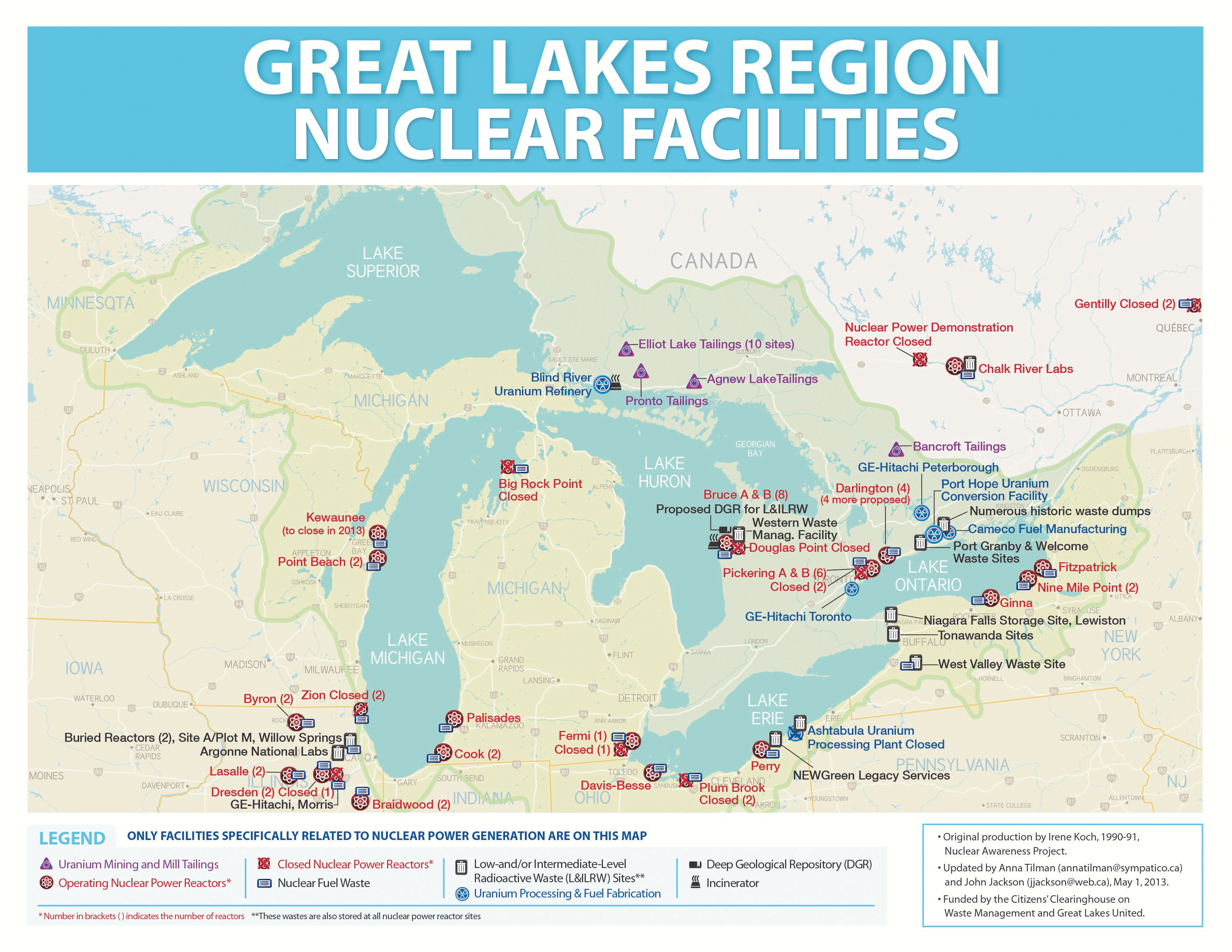
There are 18 nuclear power plants located on the shores of the Great Lakes in Canada and the United States, providing energy across the region. But what happens when these facilities come to the end of their useful life?
Nuclear power production creates radioactive wastes, and plant operators and regulators have protocols to contain and carefully manage these wastes during the process of retiring, or “decommissioning,” a nuclear plant. There are safeguards in place to minimize radioactive pollution risk during decommissioning. But radioactive pollution can persist in the environment for generations.
A new report from the IJC Great Lakes Water Quality Board recommends special precautions that governments should take to better protect Great Lakes water quality when it comes time to retire nuclear plants. As summarized in a short video, the purpose of this report is to identify potential opportunities in the decommissioning process to reduce threats to the Great Lakes environment.
On April 29, members of the board’s work group will summarize their report and answer audience questions during a 60-minute Zoom webinar. The webinar is open to all interested participants and will start at 11:30 am ET. You must register here in advance of the webinar, which will be recorded and posted to the board’s website afterward.
Nuclear power plants have a finite lifespan, ranging from 20 to 60 years. In the Great Lakes region, only Big Rock Point in Charlevoix, Michigan, has fully completed the decommissioning process. Eight other nuclear reactors at six sites around the Great Lakes are permanently shut down but have not completed decommissioning. Seven more reactors are scheduled for decommissioning by 2025, and all nuclear power facilities in the Great Lakes region are on track to be decommissioned by the end of this century, according to Canadian and US regulators.

In addition to the 18 nuclear power plants in the basin, this map shows other facilities involved in the nuclear energy lifecycle in and around the Great Lakes basin. Credit: Citizens’ Clearinghouse on Waste Management and Great Lakes United
Federal regulators in each country (the Canadian Nuclear Safety Commission and the US Nuclear Regulatory Commission) have detailed protocols for regulating nuclear facility decommissioning, but these protocols are different for each country.
“The board studied this topic because of the compelling need for Great Lakes-specific improvements to governments’ one-size-fits-all regulatory approach to decommissioning nuclear power facilities,” said Gayle Wood, Water Quality Board Canadian co-chair and retired Conservation Authorities chief administrative officer.
The board recommends binational alignment of Canada and US regulations addressing four key areas of decommissioning nuclear facilities in the Great Lakes basin: transparency and community engagement, radioactive waste storage, transportation of spent nuclear fuel, and site clean-up and long-term monitoring.
Recommendations developed through a collaborative process
To develop their recommendations, the board convened multiple workshops and panel discussions to consider a wide range of interests, including advocates and critics of nuclear energy.
“Even though we all had very different life experiences and work experiences, we agreed to work from a common basis in terms of making decisions grounded in certain principles under the Great Lakes Water Quality Agreement, things like the precautionary principle, the prevention of problems, citizen engagement and thinking for long-term,” said John Jackson, board work group project lead and Toxics Free Great Lakes Network organizer.

The board’s panel discussion in Petoskey, Michigan, included individuals and organizations that participated in the process of decommissioning the nearby Big Rock Point nuclear facility. Credit: IJC
Early in 2020 in Petoskey, Michigan, the board’s nuclear decommissioning work group convened a panel discussion to hear from individuals and organizations that participated in the process of decommissioning Big Rock Point, formerly operated by Consumers Energy.
“It was important to have the participants from our decommissioning process share their experiences with the board’s work group—the way in which our company did the stakeholder engagement and really tried to earn the trust of the local community and be transparent about what we are doing to protect our natural resources,” said Brandon Hofmeister, board member and senior vice president of governmental, regulatory and public affairs at Consumers Energy.
Jackson added: “Our report emphasizes the importance of regulators and facility operators building the trust of the community with meaningful community engagement throughout the decommissioning process.”
The US Nuclear Regulatory Commission recommends community advisory boards (CABs) as a best practice for decommissioning, but CABs are not used in Canada. These CABs are an effective tool that the board recommends both countries use to facilitate improved transparency and communications.
“The reality of the (nuclear) waste problem for the Great Lakes is that we have existing waste that is still remaining on the shores of the Great Lakes in many nuclear plants,” said Hofmeister. Also, there are growing inventories of spent nuclear fuel at every operating nuclear power plant along the shores of the Great Lakes.
To date, neither Canada nor the United States federal governments have licensed permanent radioactive waste storage facilities. Consequently, waste is temporarily stored onsite at nuclear facilities, just yards away from Great Lakes’ waters.
The board advises that governments consider tailoring regulations of nuclear facilities in the Great Lakes to specifically consider climate change impacts, such as coastal erosion and flooding, that could affect temporary onsite storage facilities.
When it comes to permanent storage, the board recommends that governments use the consent-based approach when choosing a permanent facility and advises against selecting interim or permanent storage facilities on the shores of the Great Lakes or tributary waters. The board also advises that wastes temporarily stored on Great Lakes shores be moved to a permanent facility as soon as one becomes licensed and operational.

Ontario Power Generation operates the Pickering Nuclear Generating Station near Toronto, Ontario. Some reactors are permanently shut down while others remain operational, and spent nuclear fuel is temporarily stored onsite. Credit: John McArthur via Unsplash.
The board report also provides advice to address community and environmental concerns to minimize pollution risks when nuclear waste is eventually transported to these other storage facilities.
“The long-term implications of the decommissioning of a site don’t stop when the physical building is gone, and they don’t even stop when the waste that is there is hauled away,” said Frank Ettawageshik, board work group member and executive director of the United Tribes of Michigan.
After the nuclear plant operator completes clean-up activities and remediates any pollution on the site, the land may be used for another purpose.
But the lack of requirements for ongoing monitoring leaves little room for error in the decommissioning process. The board recommends long-term monitoring at all sites to ensure that clean-up is complete and comprehensive.
The board’s report identifies opportunities in the decommissioning process to reduce threats to the Great Lakes environment. It does not evaluate the benefits or risks of nuclear power generation overall, or the science behind the relative environmental or human health risks of nuclear power production or waste. The report does not evaluate whether or where to site nuclear power facilities or how nuclear facilities are operated during their useful lifetime.
The board previously published a background report and StoryMap that compiles information about the status of the operational and decommissioned nuclear power facilities in the Great Lakes basin.

Allison Voglesong Zejnati is public affairs specialist at the IJC’s Great Lakes Regional Office in Windsor, Ontario.



